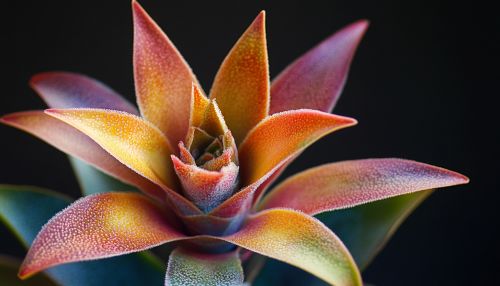Polyploidy: Difference between revisions
(Created page with "== Introduction == Polyploidy is a condition in which an organism has more than two complete sets of chromosomes. This phenomenon is particularly common in plants but can also occur in animals and other organisms. Polyploidy plays a significant role in the evolution, adaptation, and speciation of various species. == Types of Polyploidy == Polyploidy can be classified into several types based on the origin and nature of the chromosome sets: === Autopolyploidy === Autop...") |
No edit summary |
||
| (One intermediate revision by the same user not shown) | |||
| Line 14: | Line 14: | ||
Endopolyploidy is a condition where certain cells within a diploid organism become polyploid. This occurs through [[endomitosis]], a process where chromosomes replicate without cell division. Endopolyploidy is observed in various tissues of animals and plants, contributing to cell differentiation and function. | Endopolyploidy is a condition where certain cells within a diploid organism become polyploid. This occurs through [[endomitosis]], a process where chromosomes replicate without cell division. Endopolyploidy is observed in various tissues of animals and plants, contributing to cell differentiation and function. | ||
[[Image:Detail-98205.jpg|thumb|center|Close-up image of a flowering plant, showcasing its vibrant colors and intricate details.|class=only_on_mobile]] | |||
[[Image:Detail-98206.jpg|thumb|center|Close-up image of a flowering plant, showcasing its vibrant colors and intricate details.|class=only_on_desktop]] | |||
== Mechanisms of Polyploidy == | == Mechanisms of Polyploidy == | ||
Latest revision as of 18:40, 8 October 2024
Introduction
Polyploidy is a condition in which an organism has more than two complete sets of chromosomes. This phenomenon is particularly common in plants but can also occur in animals and other organisms. Polyploidy plays a significant role in the evolution, adaptation, and speciation of various species.
Types of Polyploidy
Polyploidy can be classified into several types based on the origin and nature of the chromosome sets:
Autopolyploidy
Autopolyploidy occurs when an organism has multiple sets of chromosomes derived from a single species. This can result from errors during meiosis, leading to the formation of gametes with an extra set of chromosomes. When such gametes fuse, the resulting zygote will have an increased number of chromosome sets. Autopolyploidy is common in plants such as potatoes and alfalfa.
Allopolyploidy
Allopolyploidy arises from the hybridization between two different species, followed by chromosome doubling. This type of polyploidy combines the chromosome sets of both parent species, leading to a new species with a unique genetic makeup. Examples include wheat and cotton, which are allopolyploid species.
Endopolyploidy
Endopolyploidy is a condition where certain cells within a diploid organism become polyploid. This occurs through endomitosis, a process where chromosomes replicate without cell division. Endopolyploidy is observed in various tissues of animals and plants, contributing to cell differentiation and function.


Mechanisms of Polyploidy
Polyploidy can arise through several mechanisms, including:
Meiotic Errors
Errors during meiosis, such as nondisjunction, can lead to the formation of gametes with extra sets of chromosomes. When these gametes participate in fertilization, the resulting zygote will be polyploid. Meiotic errors are a common cause of autopolyploidy.
Mitotic Errors
Mitotic errors, such as chromosome missegregation during cell division, can also result in polyploid cells. These errors can occur during early embryonic development, leading to polyploid organisms.
Hybridization
Hybridization between different species can result in allopolyploidy. The hybrid offspring may undergo chromosome doubling, stabilizing the genome and allowing the formation of a new species.
Evolutionary Significance
Polyploidy has significant evolutionary implications:
Speciation
Polyploidy can lead to the formation of new species, particularly in plants. Allopolyploidy, in particular, can create hybrids with unique genetic combinations, leading to rapid speciation.
Genetic Diversity
Polyploid organisms have increased genetic diversity due to the presence of multiple sets of chromosomes. This diversity can enhance adaptability and resilience to environmental changes.
Adaptation
Polyploidy can confer adaptive advantages, such as increased size, vigor, and tolerance to various stresses. These traits can be beneficial in changing environments, contributing to the success of polyploid species.
Polyploidy in Plants
Polyploidy is particularly prevalent in plants, where it has played a crucial role in their evolution and diversification:
Agricultural Crops
Many important agricultural crops are polyploid, including wheat, cotton, and potatoes. Polyploidy has contributed to their improved yield, disease resistance, and adaptability.
Horticultural Varieties
Polyploidy is also exploited in horticulture to create new varieties of ornamental plants with enhanced traits, such as larger flowers and increased vigor.
Polyploidy in Animals
While less common than in plants, polyploidy also occurs in animals:
Fish and Amphibians
Polyploidy is observed in certain fish and amphibian species. For example, the Salmonidae family, which includes salmon and trout, exhibits polyploidy. Polyploidy in these species can result in increased size and improved adaptability.
Invertebrates
Polyploidy is also found in some invertebrates, such as parasitic flatworms and certain insects. In these organisms, polyploidy can contribute to their reproductive strategies and survival.
Polyploidy in Humans
Polyploidy in humans is generally associated with developmental abnormalities and is often lethal. However, certain tissues, such as the liver and placenta, exhibit endopolyploidy, which plays a role in their function and regeneration.
Detection and Analysis
Several techniques are used to detect and analyze polyploidy:
Chromosome Counting
Chromosome counting involves examining the number of chromosomes in a cell using microscopy. This technique is fundamental for identifying polyploidy.
Flow Cytometry
Flow cytometry is a powerful tool for analyzing the DNA content of cells. It can be used to detect polyploidy by measuring the relative DNA content of a cell population.
Molecular Markers
Molecular markers, such as microsatellites and single nucleotide polymorphisms (SNPs), can be used to study the genetic composition of polyploid organisms. These markers provide insights into the origin and evolution of polyploidy.
Applications of Polyploidy
Polyploidy has several practical applications in agriculture, horticulture, and research:
Crop Improvement
Polyploidy is used in crop improvement programs to develop new varieties with enhanced traits, such as increased yield, disease resistance, and stress tolerance.
Breeding Programs
Polyploidy is exploited in breeding programs to create hybrids with desirable characteristics. Allopolyploidy, in particular, is used to combine the traits of different species.
Genetic Research
Polyploidy provides a unique system for studying genetic and evolutionary processes. Researchers use polyploid organisms to investigate gene expression, genome evolution, and adaptation.
Challenges and Considerations
While polyploidy offers numerous advantages, it also presents challenges:
Genetic Instability
Polyploid organisms can exhibit genetic instability due to the presence of multiple sets of chromosomes. This can lead to irregularities in chromosome segregation and gene expression.
Breeding Complexities
Breeding polyploid organisms can be complex due to the challenges in maintaining chromosome stability and fertility. These complexities require careful management in breeding programs.
Ethical Considerations
The use of polyploidy in genetic modification and breeding raises ethical considerations. It is essential to balance the benefits of polyploidy with potential ecological and ethical impacts.
Conclusion
Polyploidy is a fascinating and complex phenomenon with significant implications for evolution, adaptation, and speciation. It plays a crucial role in the diversity and success of various species, particularly in plants. Understanding the mechanisms, applications, and challenges of polyploidy provides valuable insights into the genetic and evolutionary processes that shape the natural world.
